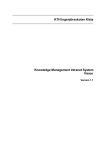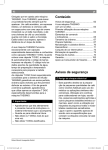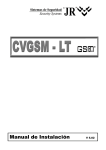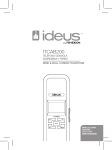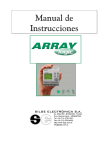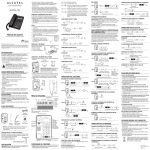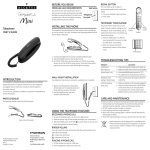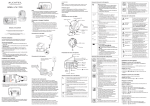Download Descargar el manual de usuario
Transcript
INSTALLING AND REPLACING THE BATTERIES Your Caller ID phone uses 3 AA-size alkaline batteries for receiving and storing Caller ID records and for storing the numbers you use for memory dialing, pulse dialing, and redial. IMPORTANT: You will have approximately 60 seconds to replace the batteries before the memories stored are lost. Please read the instructions before replacing the batteries and have the batteries ready to be inserted beforehand. IMPORTANT: If you are not going to use the telephone for more than 30 days, remove the batteries because they may leak and damage the unit. 1. If the telephone line cord is connected, disconnect it from the base unit. 2. Use a ballpoint pen or other tool to open the battery compartment door. 3. Insert 3 AA-size alkaline batteries (not included) as shown on the diagram inside the compartment. 4. Replace the battery compartment door. 5. Re-attach the line cords to the unit and check your memory locations. If installation takes longer than 60 seconds, you should re-set your memory locations. INSTALLING THE PHONE Your phone should be placed on a level surface, such as a desk or table top. CONNECTING THE HANDSET 1. Connect one end of the coiled handset cord to the jack on the handset. 2. Plug the other end of the coiled handset cord to the jack on the base. 3. Place the handset in the cradle. Telephone User’s Guide CONNECTING THE TELEPHONE LINE INTRODUCTION This product, Retro phone with Dual Mode Caller ID, can provide a features to store and display the FSK /DTMF type Caller ID information that provided by your local telephone company. Your Caller ID phone enables you to: • Identify callers before you answer the phone. • View the time and date of each incoming call. • Record up to 80 Caller ID messages sequentially. In order to use the Caller ID function on this unit, you must subscribe the Caller ID services from your telephone company. To get the most from your new phone, you are suggested to take a few minutes right now to read through this user guide. 1. Connect one end of the straight telephone line cord to the jack on the back of the base. 2. Connect the other end to a wall phone jack. NOTE: The unit is properly installed if you pick up the handset and hear the dial tone. Otherwise, recheck all installation steps. BEFORE YOU BEGIN Wall plate To use this phone, you need an RJ11C type modular telephone jack, which might look like the one pictured here, Modular installed in your home. If you don’t have telephone a modular jack, call your local phone line jack company to find out how to get one installed. IMPORTANT INSTALLATION INFORMATION CAUTION: Disconnect the phone cord from the wall outlet before installing or replacing the batteries. • Never install telephone wiring during a lightning storm. • Never touch uninsulated telephone wires or terminals, unless the telephone line has been disconnected at the network interface. • Use caution when installing or modifying telephone lines. • Never install telephone jacks in wet locations unless the jack is specifically designed for wet locations. • Temporarily disconnect any equipment connected to the phone, such as faxes, other phones, or modems. Summary Screen FLASH button REDIAL button ATLINKS 22 quai Gallieni 92150 Suresnes France www.atlinks.com Alcatel logo and Alcatel name are trademarks of Alcatel and used under license by Atlinks. SETTING THE LCD CONTRAST This adjustment allows you to adjust the contrast and viewing angle of the display. 1. To enter the setup menu, press the MENU button. SET 1 DATE appears. 2. Press the or arrow button until SET 3 LCD appears. 3. Press the MENU button to show the current contrast setting. There are 5 levels of contrast, with the default set to 2. 4. To decrease the contrast, press the arrow button. To increase, press the arrow button. 5. Press MENU again to store the contrast setting. ACTIVATE OR DEACTIVATE CALL LOCK '0' 1. To enter the setup menu, press the MENU button. SET 1 DATE appears. 2. Press the or arrow button until SET 4 Loc appears. 3. Press MENU button to activate or deactivate the call lock ‘0’ function. If the call lock ‘0’ function is deactivate, it will activate the call lock ‘0’ function. If the call lock ‘0’ function is activated, it will prompt the user to enter the password to deactivate call lock. If the password has not been entered before, it dafaults 0000. You can abort the current operating and exit by going off-hook, or by pressing 'FLASH' button. OPERATION Caller ID FEATURES STORE button DELETE button REVIEW button Bottery-low Message Waiting Day Month In-use lcon Hour Minute Lock 0 icon Incoming call Outgoing call Call-log Number New incoming call 7-seg digits When applying power for the first time, the summary screen appears. NOTE: Proceed immediately to change any of the following factory preset settings as required. 1. To enter the setup menu, press the MENU button. SET 1 DATE appears. 2. At this point you can press either arrow button to scroll through 5 menu screens: SET 1 DATE SET 2 CODE (default is ----) SET 3 LCD (default is 2) SET 4 LOC SET 5 PIN • You have 20 seconds following any key press before the unit will automatically return to the summary screen. NOTE: You can exit the setup menu by pressing the FLASH button. SETTING DATE/TIME Model Temporis Retro - EX 00030524 (Rev.1 E/S) 10-20 Made in China The Caller ID unit uses the programmed area code to determine the number format to display when a valid Caller ID signal is received. 1. To enter the setup menu, press the MENU button. SET 1 DATE appears. 2. Press the or arrow button until SET 2 CODE appears. 3. Press the MENU button to show the current local area code. The default is----. The first digit flashes, indicating it is ready to accept the area code entry. 4. Press the numeric button to enter the code, up to 4 digits max. 5. If necessary, press the DELETE button to erase the all digits. 6. Press the MENU button to store the new Area Code. EXITING THE SETUP MENU Make sure your package includes the following items: • a base and handset. • a telephone cord. • a spiral cord. TELEPHONE JACK REQUIREMENTS SETTING THE LOCAL AREA CODE 1. To enter the setup menu, press the MENU button. SET 1 DATE appears. 2. Press the or arrow button until SET 5 PIN appears. 3. Press MENU button to change the password of call lock '0'. 4. It prompt the user to enter the old password in first. 5. Afterwards, it will prompt the user to enter the new one and then re-enter again for confirmation. SETUP MENU MENU button PAUSE button DIAL button PARTS CHECKLIST NOTE: If the FSK Caller ID is received, the Date / Time will be automatically updated. CHANGE PASSWORD FOR CALL LOCK '0' FUNCTION SHORT GLOSSARY OF TERMINOLOGY USED IN THIS MANUAL Hook switch. The part of the phone that pops up to activate the phone line when the handset is lifted from the base. Off-hook. A term used to describe the phone in its active mode when the handset is off of the base cradle. On-hook. A term used to describe the phone in an inactive mode. 6. Press MENU button again to store the value. This adjustment the Caller ID date/time. 1. To enter the setup menu, press the MENU button. SET 1 DATE appears. 2. Press the MENU button to show the current year. 3. Press the or arrow button to change the current year value. 4. When the desired number is flashing, press the MENU button to the month setting. 5. Repeat steps 3 and 4 to set day, hour and minute. Caller ID (CID) is a service available from your local telephone company. For Caller ID to work on the system, you must subscribe to Caller ID service. This unit can receive the FSK and DTMF caller ID without any setting. This information may include the phone number, date and time; The unit stores up to 80 calls for later review. RECEIVING AND STORiNG CALLS When you receive a call, the information is transmitted by the phone company to your caller ID telephone. When the memory is full, a new call automatically replaces the oldest call in memory. NEW appears in the display for calls received the have not been reviewed. If a FSK Caller ID is received, it will automatically update the date /time on this unit . If the DTMF Caller ID is received, the record date/time will copy from the unit Date/Time. However, it must be set before. Area Code Management The received CID will be compared with the area code set. If both are matched, those digits will be deleted then store into the CID log. VERY IMPORTANT: The Caller ID feature of this product requires a subscription to Caller ID service from your telephone company. REVIEWING CALL RECORDS • When the NEW indicator is ON, you have received new incoming calls. Press the or arrow button to review the stored calls. After the new call records are reviewed, the indicator turns Off. • When you reach the end of the call records, the display shows ---END--• You can exit the caller ID review by pressing the 'FLASH' button. TRANSFERRING CID RECORD TO MEMORY You may transfer a Caller ID record to your phone’s memory. 1. Press the STORE button, the LCD displays the “STOrE IN” 2. You can press the or arrow button to select the CID record. 3. Press the STORE button again, the LCD displays the “ STOrE IN”. 4. At this moment, press the numeric button [0 ... 9] to select the memory location. 5. If the memory has content, it will be replaced by the new entry. DELETING CALL RECORDS TO DELETE AN INDIVIDUAL CALL When reviewing calls, you may delete an individual call by pressing the DELETE button twice. The contents of the display will be erased and the remaining Caller ID records are renumbered. TO DELETE ALL CALLS 1. When reviewing calls, you may delete all calls by pressing and holding the DELETE button for more than 3 seconds. DEL ALL? appears in the display. 2. Press DELETE button again to confirm. DIALING A CALLER ID NUMBER Dialing from On-hook: 1. Press the or arrow button to select the CID record. 2. Pick up the handset, the number will be automatically dialed out. Dialing in Off-hook: 1. Pick up the handset to make the phone in off-hook first. 2. Use the or arrow button to select he CID record. 3. Press the DIAL button to dial out the displayed number. CALLER ID MESSAGE The following indicators show the status of a message. --P-- The person is calling from a number that has been blocked from transmission. --O-- The person is calling from a number that is out of area from transmission. --E-- Caller information has been interrupted during transmission or the phone line is excessively noisy. TELEPHONE BASICS RECEIVING A PHONE CALL 1. Lift the handset to answer the call. 2. Replace the handset in the cradle to hang up. MAKING A PHONE CALL 1. Lift the handset. Wait for a dial tone. 2. Dial the telephone number you want to call. 3. Replace the handset in the cradle to hang up. VOLUME You may adjust the receiver volume from a switch that located at the rear side of the unit. REDIAL (OUT GOING CALLLOG) 2. Press [ 1 ]....[ 0 ] to select memory location. 3. Go-Off-hook to dial out the numbers. In Off-hook mode: 1. Press DIAL button. 2. Press [ 1 ]....[ 0 ] to select memory location and directly dial out the numbers. CHAIN DIALING FROM MEMORY Use this feature to make calls which require a sequence of numbers such as using a calling card for frequently called long distance number. Basically, you dial each part of the sequence from memory. The following example shows how you can use chain dialing to make a call through a long distance service: The Number For Memory Location Long distance access number Authorization code Frequently called long distance number 1. Make sure the phone is ON. 2. Press DLAL and then press 7. 3. When you hear the access tone, press DIAL and then press 8. 4. At the next access tone, press DIAL and then 9. TIP: Wait for the access tones before pressing the next memory button, or your call might not go through. INSERTING A PAUSE IN THE DIALING SEQUENCE Press the PAUSE button to insert a delay in the dialing sequence of a stored telephone number when a pause is needed to wait for a dial tone (for example after you dial 9 for an outside line, or to wait for a computer access tone). PAUSE shows in the display as a “p”, and counts as 1 digit in the dialing sequence. If you need a longar Pause, press the PAUSE button twice. VISUAL MESSAGE WAITING INDICATOR The VMWI will blank if there have a message in the centralized voice mail system. You need to contact your services provider for more details. TROUBLESHOOTING TIPS No Dial Tone • Check all cabling to make sure that all connections are secure and not damaged. • Check hook switch: Does it fully extend when handset is lifted from cradle? In On-hook mode: You can press "REDIAL" key and then the or button to review the outgoing call up to last 5 times redial number. Lift the handset to dial out the outgoing call. In Off-hook mode: You can press the REDIAL button to redial out the last number. If you press the REDIAL button after digits have been dialed out, it will break the line for a second then redial out the last number dialed. No Display • Replace the batteries. • Check for proper battery installation. DELETE REDIAL RECORD Phone Dials in Pulse with Tone Service • Make sure T/P DIAL MODE is set to TONE DIAL. During the redial record review in On-hook, press the DELETE button to delete the displayed record. If press and hold the DELETE button for 3 sec, all the redial record will be deleted. Phone Won't Dial Out with Pulse Service • Make sure T/P DIAL MODE is set to PULSE DIAL. TEMPORARY TONE DIALING If you have pulse (rotary) service and want to access customer calling services (such as telebanking and long distance services) that require tone dialing, you can use this feature to temporarily change from pulse to tone service. After dialing the telephone number and connecting to the customer calling service, 1. Press and release the TONE (*) button. 2. When you hang up, the telephone automatically returns to pulse dialing mode. PRE-DIALING 1. With the handset on the cradle, enter the telephone number wish to call (max 32 digit). The telephone number shows in the display. 2. Lift the handset, the number will be automatically dialed out. NOTE: Use the DELETE button to delete an incorrectly entered number. MEMORY Store up to ten 16-digit numbers in memory for quick dialing. STORING A NUMBER IN MEMORY 1. Press the STORE button, the LCD displays the “STOrE IN”. 2. You can enter the telephone number up to 16 digits, 3. If wrong entry, press the DELETE button to erase the last entered digit. 4. Press the STORE button again, the LCD display the “STOrE IN”. 5. Now, press the numeric button [0 ... 9] to select the memory location. 6. If the memory has a content, it will be replacea by the mew entry. MEMORY DIALING In On-hook mode: 1. Press DIAL button. 7 8 9 No Information is Shown After the Phone Rings • Are you subscribed to Caller ID service from your local telephone company? • Be sure to wait until the second ring before answering. Phone Does Not Ring • You may have too many extension phones on your line. Try unplugging some extension phones. • Check for dial tone. See Troubleshooting Tips for No Dial Tone. Incoming and Outgoing Voice Volume Low • Are other phones off hook at same time? If so, this is normal condition as volume drops when additional phones are used at once. • Check the handset receiver volume. GENERAL PRODUCT CARE To keep your phone working and looking good, follow these guidelines: • Avoid putting it near heating appliances and devices that generate electrical noise (for example, motors or fluorescent lamps). • DO NOT expose to direct sunlight or moisture. • Avoid dropping and other rough treatment to the unit. • Clean with a soft cloth. • Never use a strong cleaning agent or abrasive powder because this will damage the finish. • Retain the original packaging in case you need to ship it at a later date. Used equipment must be disposed of in compliance with current environmental protection regulations. You should return it to your reseller or dispose of it in an approved recycling centre. INSTALAR Y REEMPLAZAR LAS PILAS CONFIGURAR EL CÓDIGO DE ÁERA LOCAL Su teléfono con Identificador de llamadas utiliza 3 pilas alcalinas AA para recibir y almacenar registros del Identificador de llamadas y para almacenar los números que utiliza en el marcado desde la memoria, el marcado por pulsos y la rellamada. La unidad del Identificador de llamadas utiliza el código de área local programado para determinar el formato de número que se mostrará cuando se reciba una señal válida del Identificador de llamadas. 1. Pulse el botón MENU para ingresar en el menú Se mostrará “CONFIG 1 FECHA” en el visor. 2. Pulse el botón o hasta que se muestre “CONFIG 2 CÓD”. 3. Pulse el botón MENU para mostrar el código de área local actual. El código predeterminado es ----. El primer dígito parpadeará indicando que puede ingresar el código de área. 4. Pulse los botones numéricos para ingresar el código de 4 dígitos como máximo. 5. Si fuera necesario, pulse el botón DELETE para borrar todos los dígitos. 6. Pulse el botón MENU nuevamente para guardar el nuevo código de área. IMPORTANTE: Tendrá aproximadamente 60 segundos para reemplazar las pilas antes de que se pierdan todas las memorias almacenadas. Por favor, lea las instrucciones antes de reemplazar las pilas y tenga las pilas que va a colocar listas con anterioridad. IMPORTANTE: Si no utilizará el teléfono por más de 30 días, retire las pilas ya que podrían tener pérdidas y dañar la unidad. 1. Si el cable de línea telefónica está conectado, desconéctelo de la unidad base. 2. Utilice un bolígrafo de punta redonda u otro instrumento similar para abrir la tapa del compartimiento de las pilas. 3. Inserte 3 pilas alcalinas AA (no incluidas) según se muestra en el diagrama dentro del compartimiento. 4. Vuelva a colocar la tapa de las pilas. 5. Vuelva a conectar los cables de línea en la unidad y verifique sus registros de la memoria. Si la instalación le tomó más de 60 segundos, deberá reconfigurar los registros de la memoria. INSTALAR EL TELÉFONO Deberá colocar el teléfono sobre una superficie nivelada, como un escritorio o una mesada. CONECTAR EL MICROTELÉFONO 1. Conecte un extremo del cable enroscado en el toma del microteléfono. 2. Enchufe el otro extremo del cable enroscado en el toma de la base. 3. Coloque el microteléfono en la base. Teléfono Guía de usuario CONECTAR LA LINEA TELEFÓNICA INTRODUCCIÓN Este producto, el teléfono retro con Identificador de llamadas modo dual, puede proveerle funciones para almacenar y mostrar la información del Identificador de llamadas tipo FSK/DTMF provista por su empresa de teléfonos local. Su teléfono con Identificador de llamadas le permite: • Identificar a la persona que llama antes de contestar el teléfono. • Ver la hora y la fecha de cada llamada entrante. • Grabar hasta 80 mensajes del Identificador de llamadas en forma secuencial. Para utilizar las funciones de Identificador de llamadas, deberá suscribirse a los servicios de Identificación de llamadas provistos por su empresa de teléfonos loca. Para obtener lo máximo de su teléfono, le sugerimos que se tome unos minutes para leer esta guía de usuario. BREVE GLOSARIO DE LA TERMINOLOGIA UTILIZADA EN ESTE MANUAL Interruptor para colgar. La parte del teléfono que se levanta para activar la línea telefónica cuando toma el microteléfono de la base. Descolgado. Un término utilizado para describir al teléfono en su modo activo cuando el microteléfono se encuentra fuera de la base. Colgado. Un término utilizado para describir al teléfono en su modo inactivo ANTES DE COMENZAR LISTA DE PARTES Asegúrese que su embalaje contenga las siguientes partes: 1. Base y microteléfono 2. Cable de teléfonos 3. Cable espiralado REQUISITOS DE TOMA DE TELÉFONOS Para utilizar este teléfono, necesitará tener instalado en su hogar un toma de teléfonos modular tipo RJ11C, que puede verse similar al de la figura. Si no posee un toma de teléfonos modular, comuníquese con su empresa de teléfonos local para averiguar cómo instalar uno. NOTA: El teléfono está correctamente conectado si toma el microteléfono y oye el tono de marcado. Si no es así, verifique los pasos de instalación. Botón FLASH Toma de línea telfónica modular PRECAUCIÓN: Desconecte el cable del teléfono de la salida de la pared antes de instalar o reemplazar las pilas. • No instale el cableado telefónico durante una tormenta eléctrica. • No toque los cables y terminales no aislados a menos que la línea telefónica esté desconectada de la interfaz de red. • Tenga cuidado al instalar o modificar las líneas telefónicas. • No instale los tomas de teléfono en lugares húmedos a menos que el toma esté diseñado para lugares húmedos. • Desconecte temporariamente cualquier equipo conectado con el teléfono, tal como un fax, otros teléfonos o un módem. ATLINKS 22 quai Gallieni 92150 Suresnes France www.atlinks.com El logotipo y el nombre de Alcatel son marcas registradas de Alcatel utilizadas bajo licencia por Atlinks. ACTIVAR O DESACTIVAR EL BLOQUEO DE LLAMADAS ‘0’ 1. Pulse el botón MENU para ingresar en el menú Se mostrará “CONFIG 1 FECHA” en el visor. 2. Pulse el botón o hasta que se muestre “CONFIG 4 BLOQ”. 3. Pulse el botón MENU para activar o desactivar la función de bloqueo de llamadas “0”. Si esta función está desactivada, la activará. Si esta función está activada, el usuario deberá ingresar la contraseña para desactivar el bloqueo de llamadas. Si no ha ingresado la contraseña con anterioridad, la contraseña predeterminada es 0000. 1. Pulse el botón MENU para ingresar en el menú Se mostrará “CONFIG 1 FECHA” en el visor. 2. Pulse el botón o hasta que se muestre “CONFIG 5 PIN”. 3. Pulse el botón MENU para cambiar la contraseña del bloqueo de llamadas “0”. 4. El usuario deberá ingresar primero la contraseña anterior. 5. Luego, deberá ingresar la contraseña nueva y deberá reingresarla para confirmar. Pantalla de resumen Botón REDIAL Botón MENU Este ajuste le permite configura el contraste y el ángulo de visión del visor. 1. Pulse el botón MENU para ingresar en el menú Se mostrará “CONFIG 1 FECHA” en el visor. 2. Pulse el botón o hasta que se muestre “CONFIG 3 LCD”. 3. Pulse el botón MENU para mostrar la configuración actual de contraste. Hay 5 niveles de contraste y el nivel predeterminado es 2. 4. para disminuir el contraste, pulse el botón . Para incrementar el contraste, pulse el botón . 5. Pulse el botón MENU nuevamente para guardar la configuración de contraste. CAMBIAR LA CONTRASEÑA PARA LA FUNCIÓN DE BLOQUEO DE LLAMADAS “0” MENÚ DE CONFIGURACIÓN SALIR DEL MENÚ DE CONFIGURACIÓN Puede salir de la función actual descolgando el teléfono o pulsando el botón FLASH. OPERACIÓN CARACTERISTICAS DEL IDENTIFICADOR DE LLAMADAS Botón STORE Botón DELETE Botón PAUSE Botón DIAL Botones REVIEW Batería baja Icono bloqueo 0 Mensaje en espera Llamada entrante Icono de En Uso Día Llamada saliente Hora Minuto Mes Número de registros de llamadas Nueva llamada entrante 7 dígitos Placa para pared IMPORTANTE INFORMACIÓN ACERCA DE LA INSTALACIÓN Modelo Temporis Retro - EX 00030524 (Rev.1 E/S) 10-20 Impreso en China 1. Conecte un extremo del cable recto de línea telefónica en el toma que se encuentra en la parte posterior de la base. 2. Enchufe el otro extremo del cable en el toma de teléfonos de la pared. CONFIGURAR EL CONTRASTE DEL VISOR Cuando enchufa la unidad por primera vez, se mostrará la pantalla de resumen. NOTA: Proceda inmediatamente a cambiar cualquiera de las siguientes configuraciones preestablecidas de fábrica según sea necesario. 1. Para ingresar al menú de configuración, pulse el botón MENU y se mostrará. SET 1 DATE en el visor. 2. En este momento, puede pulsar cualquier botón de flecha para desplazarse a través de las 5 pantallas de menú. CONFIG 1 FECHA CONFIG 4 BLOQ CONFIG 2 CÓD (predeterminado: ----) CONFIG 5 PIN CONFIG 3 LCD (predeterminado: 2) • Tiene 20 segundos después de pulsar cualquier botón antes de que la unidad regrese automáticamente a la pantalla de resumen. NOTA: Puede salir del menú de configuración pulsando el botón FLASH. CONFIGURAR FECHA / HORA Esta opción ajusta la fecha / hora del Identificador de llamadas. 1. Pulse el botón MENU para ingresar en el menú Se mostrará “CONFIG 1 FECHA” en el visor. 2. Pulse el botón MENU para mostrar el año actual. . 3. Pulse el botón o para cambiar el año actual. . 4. Cuando parpadee el número deseado, pulse el botón MENU para configurar el mes. 5. Repita los pasos 3 y 4 para configurar el día, la hora y los minutos. 6. Pulse el botón MENU nuevamente para confirmar la configuración actual. NOTA: Si recibe información del Identificador de llamadas FSK, la fecha y la hora se actualizarán automáticamente. EL identificador de llamadas es un servicio provisto por su empresa de teléfonos loca. Para que el Identificador de llamadas funcione en su sistema, deberá suscribirse al Servicio de Identificación de llamadas. Esta unidad puede recibir información del identificador de llamadas FSK y DTMF sin ninguna configuración. Esta información puede incluir el número de teléfono, la fecha y la hora. La unidad almacena hasta 80 llamadas para una revisión posterior. RECIBIR Y ALMACENAR LLAMADAS Cuando recibe una llamada, la información es transmitida por su empresa de teléfonos a su teléfono con Identificador de llamadas. Cuando la memoria está llena, una nueva llamada reemplaza automáticamente a la llamada más antigua en la memoria. Se mostrará NUEVO en el visor para las llamadas que no hayan sido revisadas. Si recibe información del Identificador de llamadas FSK, actualizará automáticamente la fecha y la hora de la unidad. Si recibe información del Identificador de llamadas DTMF, le fecha y hora del registro se copiará desde la fecha y hora de la unidad. Sin embargo, deberá configurar la fecha y hora con anterioridad. UTILIZAR EL CÓDIGO DE ÁREA La información del Identificador de llamadas recibida se comparará con el código de área configurado. Si ambos coinciden, estos dígitos se eliminarán y luego se guardarán en el registro del identificador de llamadas. MUY IMPORTANTE: La función del Identificador de llamadas de este producto requiere suscripción al servicio de identificación de llamadas provisto por su empresa de teléfonos local. REVISAR LOS ERGISTROS DE LLAMADAS • Cuando se ilumine el indicador NUEVO, significa que ha recibido una nueva llamada entrante. Pulse el botón o para revisar las llamadas almacenadas. Después de revisar los nuevos registros de llamadas, el indicador se apagará. • Cuando haya llegado al final de los registros de llamadas, el visor mostrará ---FIN---. • Puede salir de la revisión de los registros del identificador de llamadas pulsando el botón FLASH. TRANSFERIR REGISTROS DEL IDENTIFICADOR DE LLAMADAS A LA MEMORIA Puede transferir un registro del Identificador de llamadas a la memoria de su teléfono. 1. Pulse el botón STORE y el visor mostrará “GUARDAR EN”. 2. Puede pulsar los botones o para seleccionar el registro del identificador de llamadas. 3. Pulse el botón STORE nuevamente y el visor mostrará “GUARDAR EN”. 4. Pulse los botones numéricos [0 ... 9] para seleccionar la ubicación en la memoria. 5. Si la memoria ya tiene contenido, será reemplazado por el nuevo registro. BORRAR REGISTROS DE LLAMADAS PARA BORRAR UNA SOLA LLAMADA Durante la revisión de las llamadas, puede borrar una sola llamada pulsando el botón DELETE dos veces. Se borrarán los contenidos del visor y se reordenarán los números de los demás registros del identificador de llamadas. PARA BORRAR TODAS LAS LLAMADAS 1. Durante la revisión de las llamadas, puede borrar todas las llamadas manteniendo pulsado el botón DELETE por más de 3 segundos. Se mostrará ¿BORRAR TODO? en el visor. 2. Pulse el botón DELETE nuevamente para confirmar. MARCAR UN NÚMERO DEL IDENTIFICADOR DE LLAMADAS Marcar un número con el teléfono colgado 1. Pulse el botón o para seleccionar el registro del Identificador de llamadas. 2. Tome el microteléfono y el número se marcará automáticamente. Marcar un número con el teléfono descolgado 1. Tome el microteléfono. 2. Utilice los botones o para seleccionar el registro del Identificador de llamadas. 3. Pulse el botón DIAL para marcar el número que se muestra en el visor. MENSAJES DEL IDENTIFICADOR DE LLAMADAS Los siguientes indicadores muestran el estado de un mensaje. --P—La persona está llamando desde un número cuya transmisión ha sido bloqueada. --O—La persona está llamando desde un número que se encuentra fuera del área de transmisión. --E—La trasmisión de la información de la persona que está llamando fue interrumpida o la línea telefónica es excesivamente ruidosa. FUNCIONES BÁSICAS DEL TELÉFONO RECIBIR UNA LLAMADA TELEFÓNICA 1. Tome el microteléfono y conteste la llamada. 2. Vuelva a colocar el microteléfono en la base para colgar. REALIZAR UNA LLAMADA TELEFÓNICA 1. Tome el microteléfono. Espere el tono de marcado. 2. Marque el número de teléfono al que desea llamar. 3. Vuelva a colocar el microteléfono en la base para colgar. VOLUMEN Puede ajustar el volumen del receptor utilizando el interruptor ubicado en la parte posterior de la unidad. RELLAMADA (REGISTRO DE LLAMADAS SALIENTES) Con el teléfono colgado Puede pulsar el botón REDIAL y luego el botón o las llamadas salientes hasta los últimos 5 números de rellamada. Tome el microteléfono y marque el número. Con el teléfono descolgado Puede pulsar el botón REDIAL para marcar el último número. Si pulsa el botón REDIAL después de haber marcado un número, habrá una interrupción en la línea por un segundo y se marcará el último número al que llamó. BORRAR UN REGISTRO DE RELLAMADA Durante la revisión del registro de rellamada con el teléfono colgado, pulse el botón DELETE para borrar el registro que se muestra. Si pulsa y mantiene pulsado el botón DELETE por 3 segundos, se borrarán todos los registros de rellamada. MARCADO TEMPORARIO POR TONOS Si usted posee servicio por pulsos (rotativo) y desea acceder a los servicios de llamada del cliente (tal como banca telefónica y servicios de larga distancia) que requieren de marcado por tonos, puede utilizar esta función para cambiar temporariamente del servicio por pulsos al servicio por tonos. Después de haber marcado el número de teléfono y haberse comunicado con el servicio de llamada del cliente, 1. Pulse el botón TONE (*). 2. Cuando cuelgue, el teléfono regresará automáticamente al modo de marcado por pulsos. MARCADO PREVIO 1. Con el microteléfono colgado, ingrese el número de teléfono al que desea llamar (máximo de 32 dígitos). Se mostrará el número de teléfono en el visor. 2. Tome el microteléfono y el número se marcará automáticamente. NOTA: utilice el botón DELETE para borrar un número que haya ingresado incorrectamente. MEMORIA Puede almacenar hasta diez números de 16 dígitos en la memoria para el marcado rápido. ALMACENAR UN NÚMERO EN LA MEMORIA 1. Pulse el botón STORE y el visor mostrará “GUARDAR EN”. 2. Puede ingresar un número de teléfono de hasta 16 dígitos. 3. Si ingresa un número incorrecto, pulse el botón DELETE para borrar el último dígito ingresado. 4. Pulse el botón STORE nuevamente y el visor mostrará “STORE IN”. 5. Pulse un botón numérico [0 ... 9] para seleccionar la ubicación en la memoria. 6. Si la memoria ya tiene contenido, este será reemplazado por el nuevo registro. MARCAR DESDE LA MEMORIA Con el teléfono colgado: 1. Pulse el botón DIAL. 2. Pulse un botón [ 1 ]....[ 0 ] para seleccionar la ubicación en la memoria. 3. Tome el microteléfono para marcar el número. Con el teléfono descolgado: 1. Pulse el botón DIAL. 2. Pulse un botón [ 1 ]....[ 0 ] para seleccionar la ubicación en la memoria y marcar directamente el número. MARCAR EN CADENA DESDE LA MEMORIA Utilice esta función para realizar llamadas que requieren de una secuencia de números tales como utilizar una tarjeta de llamadas para números de larga distancia a los que llama con frecuencia. Básicamente, marca cada parte de la secuencia desde la memoria. El siguiente ejemplo muestra cómo puede utilizar el marcado en cadena para realizar una llamada a través del servicio de larga distancia. Número para Ubicación en la memoria Número de acceso a larga distancia Código de autorización Número de larga distancia al que llama con frecuencia 7 8 9 1. Asegúrese que el teléfono está encendido. 2. Pulse el botón DIAL y luego pulse 7. 3. Cuando oiga el tono de marcado, pulse el botón DIAL y luego pulse 8. 4. Después de oír el siguiente tono, pulse el botón DIAL y luego pulse 9. ATENCIÓN: Espere el tono de acceso antes de pulsar el siguiente botón de la memoria o es posible que falle la llamada. INSERTAR UNA PAUSA EN LA SECUENCIA DE MARCADO Pulse el botón PAUSE para insertar una pausa en la secuencia de marcado de un número de teléfono almacenado cuando ésta sea necesaria para esperar el tono de marcado (por ejemplo, después de marcar 9 para obtener línea externa o esperar para el tono de acceso de la computadora). Se mostrará la pausa en el visor como una “P” y se considerará como un dígito en la secuencia de marcado. Si necesita una pausa mayor, pulse el botón PAUSE dos veces. INDICADOR VISUAL DE MENSAJE EN ESPERA El indicador visual de mensaje en espera parpadeará si tiene un mensaje de voz en el sistema de correo de voz centralizado. Deberá contactarse con el proveedor del servicio para obtener más detalles. SOLUCIÓN DE PROBLEMAS No Hay Tono De Marcado • Asegúrese de que todas las conexiones se encuentren bien y que no estén dañadas. • Verifique que el interruptor para colgar se extienda por completo cuando toma el microteléfono de la base. No Se Muestra Nada En El Visor • Reemplace las pilas. • Verifique que las pilas estén bien instaladas. No Se Muestra Información Alguna Después De Que Suena El Teléfono • ¿Está suscripto al servicio de Identificación de llamadas provisto por su empresa de teléfonos local? • Asegúrese de esperar hasta el segundo timbre antes de contestar la llamada. El Teléfono Marca Por Pulsos Con Un Servicio Por Tonos • Asegúrese de que el modo de marcado T/P esté configurado en marcado por tonos. El Teléfono No Marca Con Servicio Por Pulsos • Asegúrese de que el modo de marcado T/P esté configurado en marcado por pulsos. El Teléfono No Suena • Es posible que tenga muchas extensiones en una misma línea. Pruebe desenchufar algunas de las extensiones. • Verifique el tono de marcado. Consulte la solución para No hay tono de marcado. Bajo Volumen De Voz Entrante Y Saliente • ¿Hay otros teléfonos descolgados al mismo tiempo? Si es así, es normal que el volumen disminuya cuando se utilizan teléfonos adicionales al mismo tiempo. • Verifique l volumen del receptor del microteléfono. CUIDADO GENERAL DEL PRODUCTO Para mantener su teléfono en funcionamiento y en buen estado, preste atención a las siguientes pautas: 1. Evite colocar el teléfono cerca de dispositivos de calor y equipos que generen ruido eléctrico (por ejemplo, motores y lámparas fluorescentes). 2. NO exponga la unidad a luz solar directa ni a humedad. 3. Evite arrojar la unidad o cualquier otro tratamiento brusco. 4. Limpie con un paño suave. 5. NO utilice fuertes agentes de limpieza ni polvos abrasivos para limpiar la unidad ya que esto podría dañar el acabado. 6. Guarde el embalaje original en caso de que necesite transportar la unidad en el futuro. El equipo usado deberá eliminarse en cumplimiento de las reglamentaciones de protección del medio ambiente actuales. Deberá enviarlos a su revendedor o eliminarlos en un centro de reciclado aprobado.



